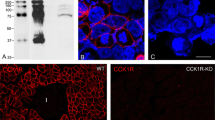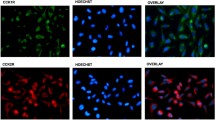Abstract
Purpose. To investigate the effects of increasing concentrations of cholecystokinin octapeptide (CCK-8) on a pancreatic acinar adenocarcinoma.
Methods. Growth of the tumour was estimated in vivo on rats bearing a subcutaneous pancreatic carcinoma, and in vitro on primary cultured tumour cells. CCK receptors were characterized by binding assays.
Results. CCK-8, administered for 12 successive days, exerted a biphasic action on tumour growth: a dose-dependent stimulation with low doses (0.1 and 0.5 μg/kg) and inhibition with high doses (2 and 4 μg/ kg) as shown by respective increases and decreases in tumor volume, protein, RNA and amylase contents. In cell cultures, [3H]thymidine incorporation was dose-dependently increased with 10−10 to 10−8 M CCK-8 and inhibited with 10−7 M. Both effects were completely suppressed by the CCK-receptor antagonists CR 1409 and L 364,718 (10−4 M). Binding studies showed the overexpression of two classes of CCK-A receptors of low and high affinity when compared to the normal pancreas which was less sensitive to CCK-8.
Conclusions. CCK-8 exerts a biphasic growth response on the acinar pancreatic carcinoma, mediated by two classes of CCK-A receptors overexpressed in the tumour.
Similar content being viewed by others
REFERENCES
A. Hajri, M. Aprahamian, and C. Damgé. Effect of a new CCK-receptor antagonist, CR 1409, on pancreatic growth induced by caerulein, CCK-8, bombesin and gastrin-releasing peptide in the rat. Regul. Pept. 43:66–72 (1989).
L. Karsenty, A. Hajri, M. Aprahamian, J. C. Garaud, M. Doffoël, and C. Damgé. Inhibition of growth of transplanted rat pancreatic acinar carcinoma with CCK-8. Pancreas 8:204–211 (1993).
M. Meijers, A. van Garderen-Hoetmer, C. B. Lamers, L. C. Rovati, J. B. Jansen, and R. A. Woutersen. Effects of the synthetic trypsin inhibitor camostate on the development of N-nitrosobis (2-oxy-propyl) amine-induced pancreatic lesions in hamsters. Cancer Lett. 60:205–211 (1991).
S. P. Povoski, W. Zhou, D. S. Longnecker, R. T. Jensen, S. A. Mantey, and R. H. Bell Jr. Stimulation of in vivo pancreatic growth in the rat is mediated specifically by the way of cholecystokinin-A receptors. Gastroenterology 107:1135–1146 (1994).
J. R. Wisner, R. E. Mc Laughlin, K. A. Rich, S. Ozawa, and I. G. Renner. Effects of L-364,718, a new cholecystokinin receptor antagonist, on camostate-induced growth of the rat pancreas. Gastroenterology 94:109–113 (1988).
M. Chu, J. F. Rehfeld, and K. Borch. Chronic endogenous hypercholecystokinemia promotes pancreatic carcinogenesis in the hamster. Carcinogenesis 18:315–320 (1997).
D. S. Longnecker, B. D. Roebuck, J. D. Yager, H. S. Lilja, and B. Siegmund. Pancreatic carcinoma in azaserine-treated rats: Induction, classification and dietary modulation of incidence. Cancer 47:1562–1572 (1981).
A. G. Howatson and D. C. Carter. Pancreatic carcinogenesis-enhancement by cholecystokinin in the hamster nitrosamine-model. Br. J. Cancer 51:107–114 (1985).
F. E. Johnson, M. C. La Regina, S. A. Martin, and H. M. Bashiti. Cholecystokinin inhibits pancreatic and hepatic carcinogenesis. Cancer Detect. Prev. 6:389–402 (1983).
A. Andrén-Sandberg, S. Dawiskiba, and I. Ihse. Studies on the effect of caerulein administration on experimental pancreatic carcinogenesis. Scand. J. Gastroenterol. 19:122–128 (1984).
J. P. Smith, T. E. Solomon, S. Bagheri, and S. Kramer. Cholecystokinin stimulates growth of human pancreatic carcinoma SW-1990. Dig. Dis. Sci. 35:1377–1384 (1990).
C. M. Townsend Jr, R. B. Franklin, L. C. Watson, E. J. Glass, and J. C. Thompson. Stimulation of pancreatic cancer growth by caerulein and secretin. Surg. Forum 32:228–229 (1981).
C. Hudd, M. C. La Regina, J. E. Devine, D. C. Palmer, D. R. Herbold, M. C. Beinfeld, F. B. Gelder, and F. E. Johnson. Response to exogenous cholecystokinin of six human gastrointestinal cancers xenografted in nude mice. Am. J. Surg. 157:386–394 (1989).
R. Maani, C. M. Townsend, G. Gomez, J. C. Thompson, and P. Singh. A potent CCK receptor antagonist (L 364,718) inhibits growth of human pancreatic cancer in nude mice [Abstract]. Gastroenterology 94:A274 (1988).
B. R. Douglas, R. A. Woutersen, J. B. M. J. Jansen, A. J. L. De Jong, L. C. Rovati, and C. B. H. W. Lamers. Influence of cholecystokinin antagonist on the effects of cholecystokinin and bombesin on azaserine-induced lesions in rat pancreas. Gastroenterology 96:462–469 (1989).
E. F. Lhoste, B. D. Roebuck, and D. S. Longnecker. Stimulation of the growth of azaserine-induced nodules in the rat pancreas by dietary camostate (FOY305). Carcinogenesis 9:901–909 (1988).
M. Meijers, M. J. Appel, A. van Garderen-Hoetmer, C. B. Lamers, L. C. Rovati, J. B. Jansen, and R. A. Woutersen. Effects of cholecystokinin and bombesin on development of azaserine-induced pancreatic tumours in rats: modulation by the cholecystokinin receptor antagonist lorglumide. Carcinogenesis 13:1525–1528 (1992).
T. P. O'Connor, B. D. Roebuck, and T. C. Campbell. Dietary intervention during the postdosing phase of L-azaserine-induced preneoplastic lesions. J. Natl. Cancer Inst. 75:955–957 (1985).
O. H. Lowry, N. J. Rosebrough, A. L. Farr, and R. J. Randall. Protein measurement with the folin phenol reagent. J. Biol. Chem. 193:265–275 (1951).
A. Danielsson. Technique for measuring amylase secretion from pieces of mouse pancreas. Anal. Biochem. 59:220–234 (1974).
G. M. Richards. Modifications of the diphenylamine reaction giving increased sensitivity and simplicity in the estimation of DNA. Anal. Biochem. 57:369–376 (1974).
W. C. Schneider. Determination of nucleic acids in tissues by pentose analysis. In: S. P. Colowick and N. O. Kaplan (eds), Methods of enzymology, New York: Academic Press, 1957, pp. 680–684.
A. Hajri, C. Bruns, P. Marbach, M. Aprahamian, D. S. Longnecker, and C. Damgé. Inhibition of the growth of transplanted rat pancreatic acinar carcinoma with octreotide. Eur. J. Cancer 27:1247–1252 (1991).
C. Stock-Damgé, M. Aprahamian, E. Lhoste, J. Marescaux, and E. Loza. Small bowel bypass prevents the trophic action of cholecystokinin on the rat pancreas. Int. J. Pancreatol. 2:257–267 (1987).
R. H. Bell Jr, E. T. Kuhlmann, R. T. Jensen, and D. S. Longnecker. Overexpression of cholecystokinin receptors in azaserine-induced neoplasms of the rat pancreas. Cancer Res. 52:3295–3299 (1992).
W. Zhou, S. P. Povoski, D. S. Longnecker, and R. H. Bell Jr. Novel expression of gastrin (cholecystokinin-B) receptors in azaserine-induced rat pancreatic carcinoma: receptor determination and characterization. Cancer Res. 52:6905–6911 (1992).
J. L. Scemama, D. Fourmy, A. Zahidi, L. Pradayrol, C. Susini, and A. Ribet. Characterization of gastrin receptors on a rat pancreatic acinar cell line (AR4-2J). A possible model for studying gastrin mediated cell growth and proliferation. Gut 28:233–236 (1987).
C. Seva, L. De Vries, J. L. Scemama, P. Sarfati, T. G. Nicolet, L. Pradayrol, and N. Vaysse. Gastrin modulates growth of a rat acinar pancreatic cell line: receptor analysis and signal transduction. Digestion 46(suppl 2):166–169 (1990).
S. P. Povoski, W. Zhou, D. S. Longnecker, B. D. Roebuck, and R. H. Bell Jr. Stimulation of growth of azaserine-induced putative preneoplastic lesions in rat pancreas is mediated specifically by way of cholecystokinin-A receptors. Cancer Res. 53:3925–3929 (1993).
B. J. Tsuei, S. P. Povoski, W. Zhou, and R. H. Bell Jr. Gastrin receptor expression during azaserine-induced rat pancreatic carcinogenesis. J. Surg. Res. 63:105–109 (1996).
D. H. Yu, S. C. Huang, S. A. Wank, S. Mantey, J. D. Gardner, and R. T. Jensen. Pancreatic receptors for cholecystokinin: evidence for three receptor classes. Am. J. Physiol. 258:G86–95 (1990).
D. S. Louie, J. P. Liang, and C. Owyang. Characterization of a new CCK antagonist, L 364,718: in vitro and in vivo studies. Am. J. Physiol. 255:G261–266 (1988).
Author information
Authors and Affiliations
Rights and permissions
About this article
Cite this article
Hajri, A., Damgé, C. Effects of Cholecystokinin Octapeptide on a Pancreatic Acinar Carcinoma in the Rat. Pharm Res 15, 1767–1774 (1998). https://doi.org/10.1023/A:1011973015634
Issue Date:
DOI: https://doi.org/10.1023/A:1011973015634




